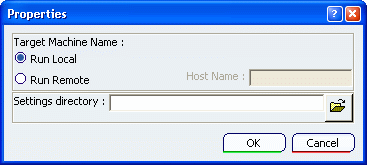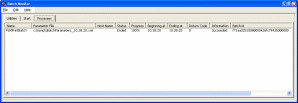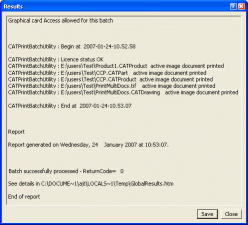Running a Batch Directly from the Batch Monitor | ||
| ||
Access the Batch Monitor, either from the command line or from a V6 session.
In the Utilities tab, click the batch to be run.
Select File > Associate a parameter file (or right-click the batch then select Associate a parameter file).
Navigate to the folder in which you saved the XML file then click Open to validate.
Access the Start tab which now displays the name and location of the XML file you associated to the batch:

Optional: Select Edit > Properties (or right-click the batch then select Properties).

Optional: Specify the target machine name by selecting the appropriate option (if you run the batch on a remote machine, you must indicate its name in the Host Name box).
By default, batches are run on your local machine. For more information about running a batch in remote mode, see Running Batches in Remote Mode.
Note that the Properties contextual command is grayed out if it is not available for the batch you are running.
Optional: In the Settings directory box, enter the path of the settings directory to be used to run the batch (or click
 then browse your file tree to the directory of your choice).
then browse your file tree to the directory of your choice).After clicking OK, the path of the selected directory is displayed in the Settings Path column of the Start tab.
Note: You can use a settings file whether in local or remote mode.
Select File > Run (or right-click the batch to run then select Run).
The batch execution starts.
Tip: - You can instantiate another batch while the current batch is running.
- The Start tab also lets you delete a batch from the list by selecting it from the list then selecting Edit > Delete (or by right-clicking then selecting Delete).
Access the Processes tab.
Information on the batch execution is displayed:

The following batch-related information is displayed:
- Name of the batch.
- Name of the parameter file used to run the batch.
- Status of the batch ("Ended", etc.).
- Start and end time, respectively in the "Beginning at" and "Ending at" columns.
- Return code: "0" means that the batch executed correctly ; a code other than zero means that the batch has failed. For more information, see Generic Batch Monitor Error Codes and Generic Batch Error Codes in the table below.
- Result of the batch execution (either "Succeeded" or "Failed").
- Batch identification number.
Generic Batch Monitor Error Codes 1: Command line syntax error. 2: Error in XML parameter file. 3: Communication layer error. 5: License acquisition error. 6: Invalid library error. 7: Error attempting to launch a batch requiring a graphic adapter on a machine without an adapter. 9: Miscellaneous. Generic Batch Error Codes 0: Batch completely successful. 4: Batch partially successful. 8: Batch failed. 20: Error checking licenses. 21: Error accessing INPUT/OUTPUT. The Processes tab also lets you interrupt the batch execution. To do so, right-click the desired batch in the list then select Interrupt.You can also delete a batch from the list by right-clicking the corresponding line then selecting Delete.
To display the report of the batch execution, double-click the desired batch.
The Results window indicates the beginning and end date and time of the batch execution as well as the name and path of the documents that have been processed.
You can then:
- Click Save to save your results (i.e. the data displayed in the Results window) in the folder of your choice. The file formats available are .txt and .xml
- Click Close to close the window and go back to the Batch Monitor.
Select File > Exit to exit the Batch Monitor.
